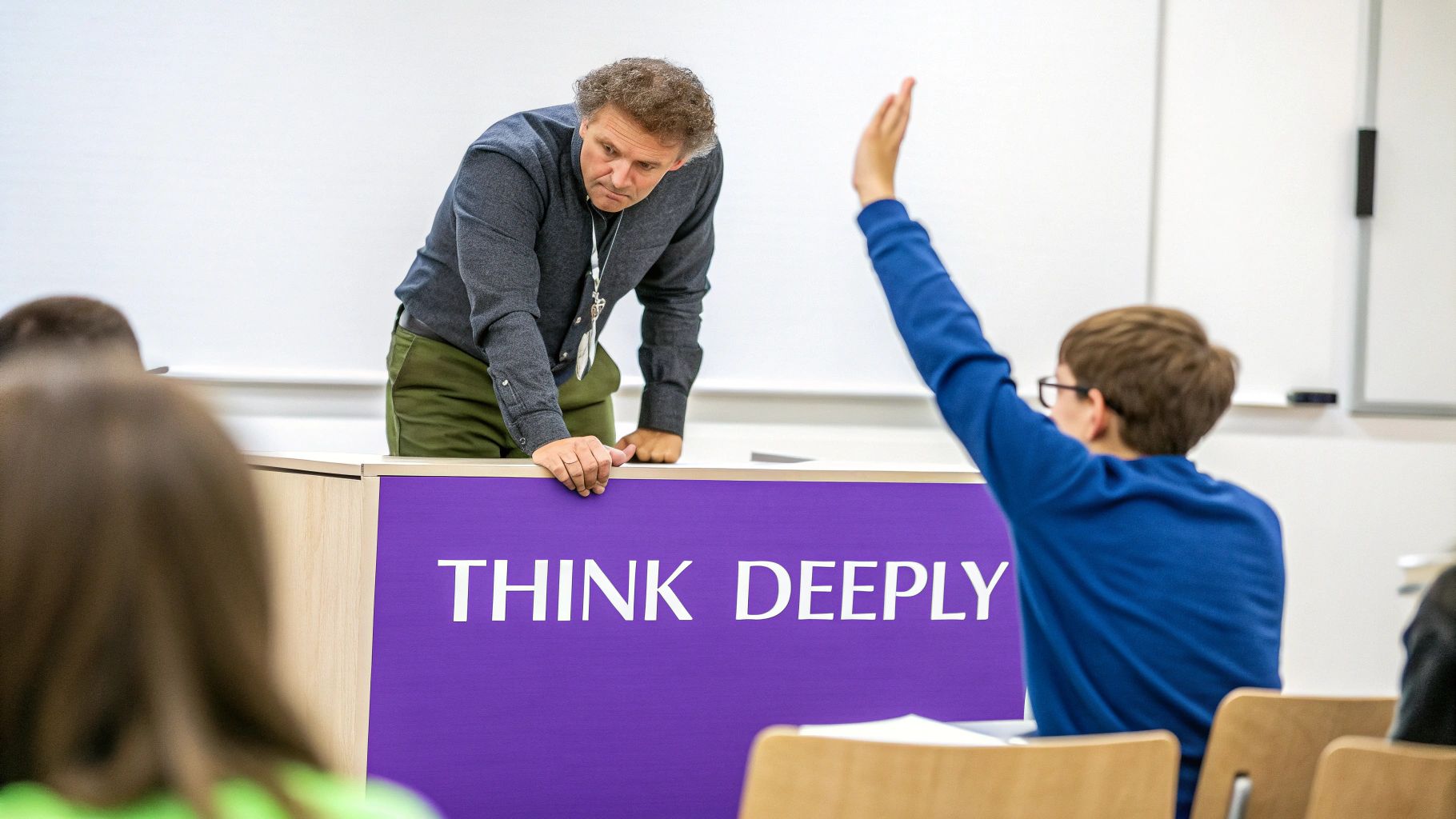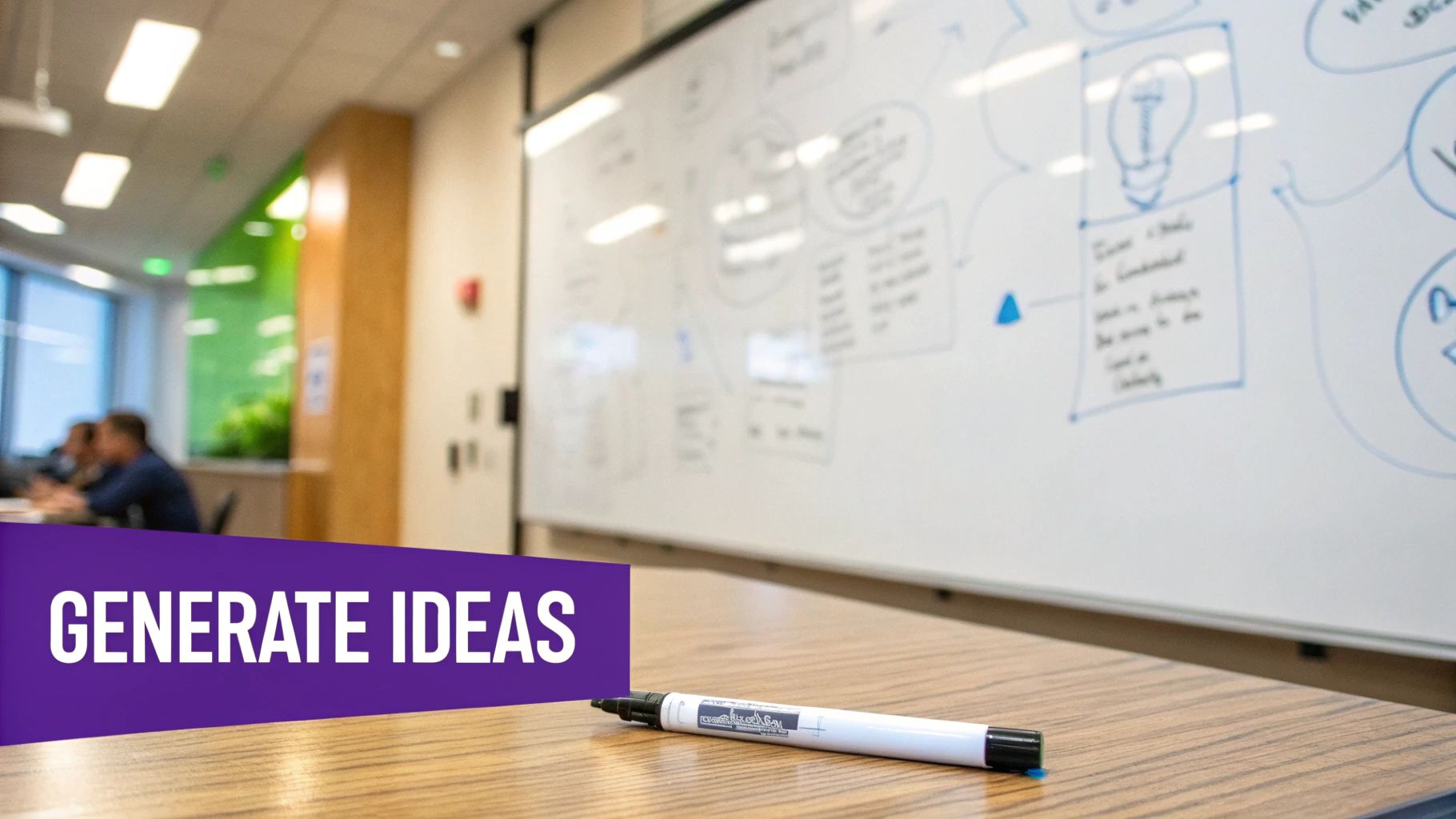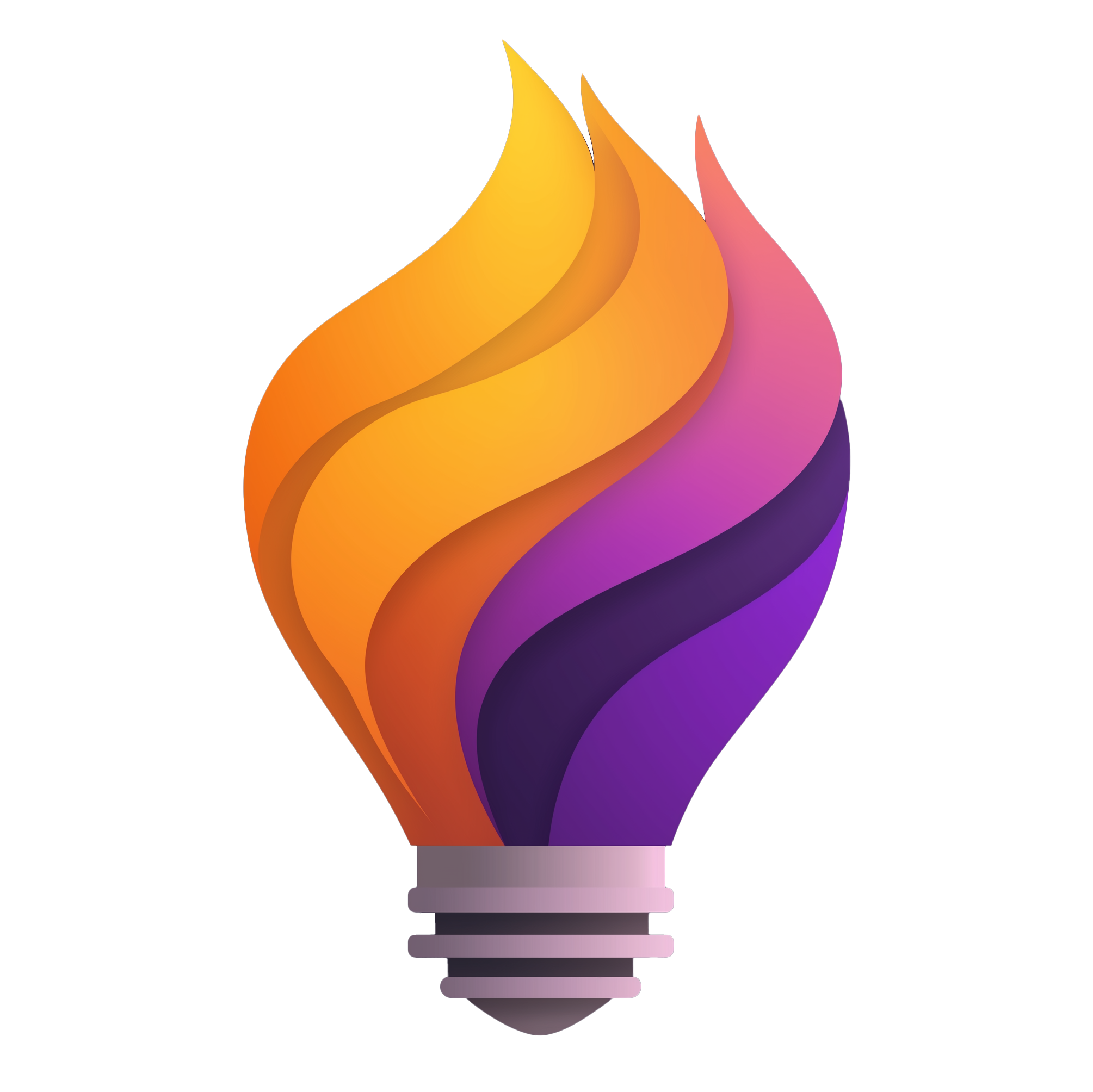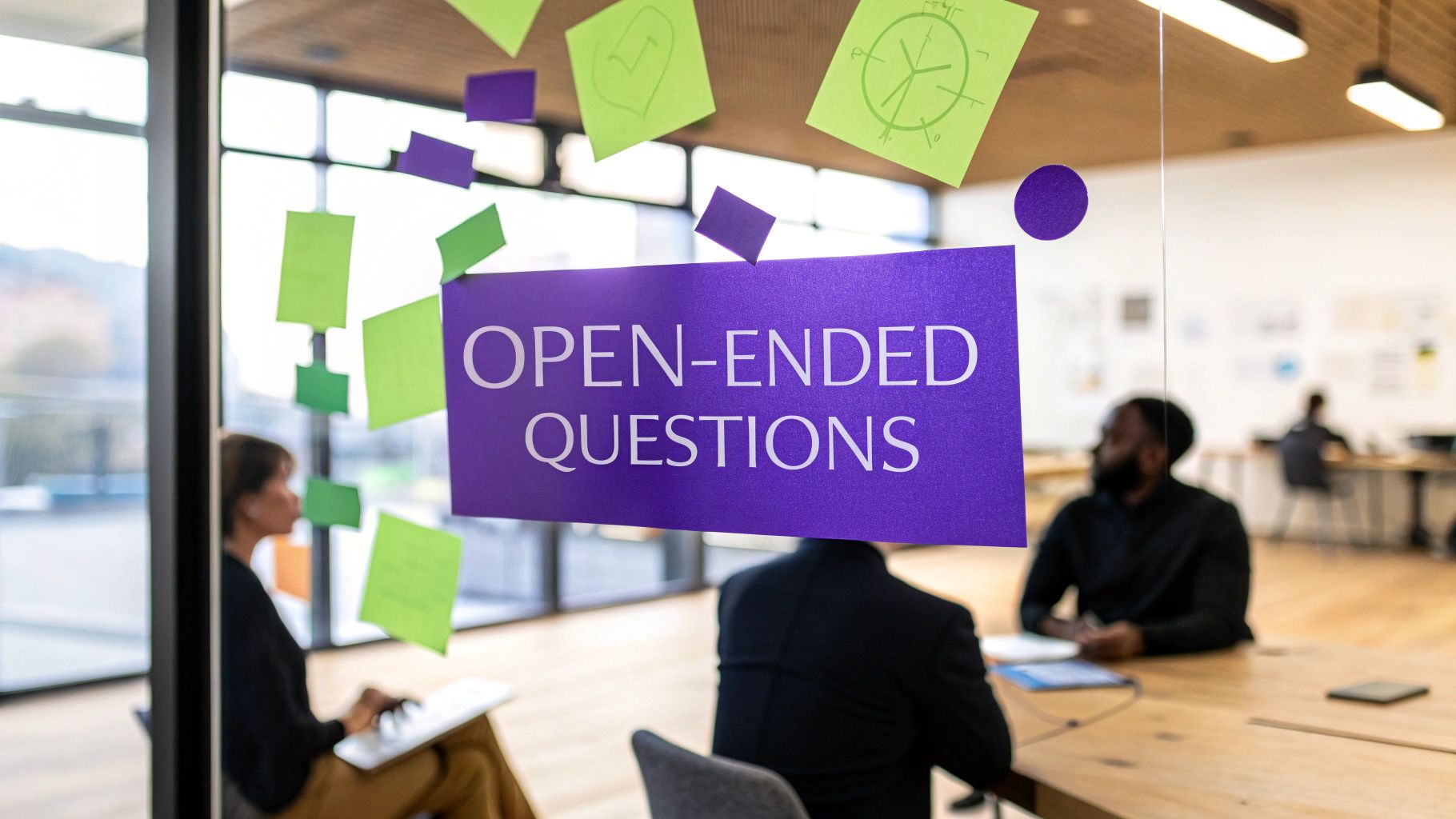In a world of quick answers and surface-level data, the power of a well-crafted question is more critical than ever. Unlike closed questions that limit responses to a simple 'yes' or 'no', open-ended questions invite detailed, thoughtful, and often surprising answers. They are the keys to unlocking genuine customer feedback, uncovering the root cause of complex problems, and sparking true innovation.
Mastering the art of asking open-ended questions is a superpower in any professional setting, from client discovery calls to internal team retrospectives. This guide moves beyond generic advice to provide a comprehensive list of open ended questions examples, each with a strategic breakdown and actionable takeaways. We will explore specific tactics for different scenarios, helping you move beyond simple inquiries and start fostering truly meaningful dialogue.
You will learn how to apply these techniques to:
- Gather deeper customer insights.
- Facilitate more effective brainstorming sessions.
- Conduct more revealing interviews.
- Drive better outcomes in coaching and team meetings.
By the end of this article, you will have a practical toolkit of questions and the strategic knowledge to use them effectively, transforming your interactions and leading to more informed, creative, and collaborative results.
1. Open-Ended Questions in Customer Feedback
Open-ended questions are a cornerstone of effective customer feedback, allowing you to collect rich, qualitative insights that multiple-choice questions simply can't capture. Instead of guiding users toward predefined answers, these questions invite them to share their experiences, frustrations, and ideas in their own words. This approach uncovers the "why" behind customer behavior, providing deep context that is crucial for genuine product and service improvement.
For example, a simple closed-ended question like "Were you satisfied with our customer service?" (Yes/No) only tells you if a customer was happy. In contrast, an open-ended version like, "What was your experience with our customer service today?" uncovers specific details about the interaction, agent performance, and emotional journey.
Strategic Breakdown and Analysis
Companies like Amazon and Netflix integrate open-ended feedback directly into their review and recommendation systems. When a customer leaves a star rating, they are often prompted with a simple but powerful question: "What did you like or dislike?" This strategy gathers a massive volume of unstructured data that, when analyzed, reveals common themes, feature requests, and unexpected pain points.
Key Tactic: Pair a quantitative question (like a rating) with a qualitative open-ended question. This combination allows you to segment feedback based on satisfaction scores (e.g., analyzing all 1-star reviews) while understanding the specific reasons behind those scores.
Actionable Takeaways
- Be Specific but Not Leading: Avoid overly broad questions. Instead of "Any feedback?" ask, "How can we improve our product to better meet your needs?" This focuses the user's response on actionable suggestions.
- Use Thematic Analysis: For remote teams handling large volumes of feedback, use tools to identify recurring themes and keywords. This helps quantify qualitative data and prioritize improvements.
- Create Space for Answers: Whether in a survey or an app, ensure the text field is large enough to encourage detailed responses. A small box signals you expect a short answer.
By incorporating these types of open ended questions examples, you move beyond surface-level metrics and start a meaningful dialogue with your customers. You can find more practical examples and strategies to deploy them by exploring samples of open-ended questions tailored for various business scenarios.
2. The "Why" Line of Questioning
The "Why" line of questioning is a systematic technique that repeatedly asks "Why?" to uncover the root causes of a problem or the core motivations behind a decision. Instead of accepting surface-level answers, this method drills down through layers of symptoms to find the fundamental issue. It transforms a simple observation into a deep diagnostic tool, making it one of the most powerful open ended questions examples for problem-solving.
For instance, a team might state, "Project delivery is delayed." Asking "Why?" reveals deeper issues: "Resources are unavailable." A further "Why?" might uncover, "Capacity wasn't planned correctly," exposing a process failure rather than a simple resource shortage.

Strategic Breakdown and Analysis
This technique, often called the "5 Whys," was famously developed by Toyota as a cornerstone of its lean manufacturing system. When a production line stopped, engineers would ask "Why?" five times to identify the root cause of the malfunction, ensuring they fixed the underlying process instead of just the immediate technical glitch. This approach prevents problems from recurring and fosters a culture of continuous improvement.
Key Tactic: Use this method collaboratively with the person or team closest to the problem. Their direct experience is essential for providing accurate answers at each stage of questioning, preventing speculation and leading to a more effective solution.
Actionable Takeaways
- Maintain Neutral Language: Frame your questions non-confrontationally. Instead of an accusatory "Why did you do that?" try "Can you help me understand why that decision was made?" This encourages open dialogue rather than defensiveness.
- Stop at the Right Point: While "5 Whys" is a guideline, the goal is to stop when you identify a broken or missing process. Continuing to ask "Why?" beyond this point often leads to unproductive blame.
- Focus on Process, Not People: The "Why" analysis should expose systemic failures, not individual mistakes. The ultimate goal is to improve the system so the error cannot be repeated by anyone.
3. Exploratory Interview Questions
Exploratory interview questions are the bedrock of qualitative research, particularly in user experience (UX) and product discovery. Instead of seeking specific answers, these unstructured or semi-structured questions are designed to open a broad conversation, allowing the respondent to guide the narrative. This technique helps researchers understand a user's world, motivations, and pain points from their perspective, without the constraints of a rigid questionnaire.
For instance, asking "Did you like the new feature?" (Yes/No) provides minimal insight. A far more effective exploratory question would be, "Can you walk me through the last time you used the new feature?" This invites a story, revealing context, emotions, and unexpected user behaviors that are critical for genuine, user-centered design.
Strategic Breakdown and Analysis
Pioneers in design thinking like IDEO and UX research leaders such as the Nielsen Norman Group have built their methodologies around this approach. They use exploratory questions during the initial phases of a project to immerse themselves in the user's experience. A common example is asking, "Tell me about your typical day," to understand how a product fits (or doesn't fit) into a person's life, rather than just focusing on the product itself.
Key Tactic: Use a "grand tour" question to start the interview. Questions like "Describe your process for [completing a task]" or "Tell me about your environment" encourage the user to provide a rich, detailed narrative, which you can then explore with more specific follow-up probes.
Actionable Takeaways
- Start Broad, Then Narrow: Begin with high-level questions like, "Describe a time when this software frustrated you." Use active listening to identify interesting points and then ask follow-up questions to dig deeper.
- Create a Comfortable Environment: An exploratory interview relies on honesty. Ensure the setting is relaxed and your tone is non-judgmental to encourage candid sharing. For remote teams, this means checking audio/video quality and building rapport at the start of the call.
- Follow the Guide, Not the Script: Use your interview guide as a checklist of topics to cover, not a rigid script. Be prepared to deviate and follow unexpected but valuable tangents that arise from the conversation.
By using these kinds of open ended questions examples, you can uncover deep insights that lead to breakthrough innovations. You can learn how to apply these techniques by exploring methods for how to conduct effective user research for your own projects.
4. Socratic Questions in Education and Training
Socratic questions are a powerful tool in education and training, designed to guide learners toward self-discovery rather than simply feeding them information. This method, rooted in the dialogues of Socrates, uses probing open-ended questions to stimulate critical thinking, challenge assumptions, and deepen understanding. Instead of providing answers, the facilitator or educator asks questions that force learners to examine their own logic and arrive at conclusions on their own.

For instance, instead of stating a fact like "This project failed due to poor communication," a leader using the Socratic method might ask, "What were the key factors that led to this project's outcome?" This invites the team to analyze the situation from multiple perspectives and take ownership of the insights. The principles of Socratic questioning are foundational in modern educational approaches like Inquiry-based learning, which drives student engagement through exploration and discovery.
Strategic Breakdown and Analysis
Modern leadership development and executive coaching programs, like those at the Center for Creative Leadership, heavily rely on Socratic questioning. Coaches don't give executives the answers; they ask questions like, "How might your team perceive that decision?" or "What assumptions are you making about this situation?" This empowers leaders to develop their own problem-solving skills and self-awareness, leading to more sustainable growth.
Key Tactic: Use layering in your questions. Start with a broad question ("What do you think caused that?") and follow up with progressively deeper ones ("Why do you believe that was the primary cause?" and "What evidence supports that belief?"). This peels back the layers of an issue.
Actionable Takeaways
- Establish a Safe Environment: Socratic questioning requires psychological safety. Ensure learners feel comfortable exploring ideas and admitting they don't know the answer without fear of judgment.
- Embrace Patient Silence: After asking a question, wait. Rushing to fill the silence robs the learner of valuable thinking time. Patience signals that a thoughtful response is expected.
- Model Curiosity: As a facilitator, show that you are also open to learning. Frame questions with genuine curiosity rather than as a test, fostering a collaborative and engaging environment.
By mastering these types of open ended questions examples, you can transform passive learning into an active, empowering experience. Learn more about how to guide these powerful conversations by exploring our facilitation skills training resources.
5. Discovery and Needs Assessment Questions
Discovery and needs assessment questions are the bedrock of successful sales, consulting, and client services. Instead of pitching a solution prematurely, these open-ended prompts help professionals deeply understand a client's world, including their challenges, goals, and operational realities. This approach shifts the dynamic from a transactional sale to a collaborative partnership, ensuring that any proposed solution is directly aligned with the client's actual needs.
For instance, a closed-ended question like, "Do you need a new CRM?" gets a simple yes or no. The open-ended alternative, "What challenges in your current sales process are preventing your team from hitting its targets?" uncovers specific pain points, process inefficiencies, and the true business impact of the problem, laying the groundwork for a tailored, high-value solution.
Strategic Breakdown and Analysis
Methodologies like SPIN Selling, popularized by Neil Rackham, and frameworks used by enterprise sales teams at Salesforce and IBM, are built around a logical sequence of open-ended questions. They move from understanding the broad situation to identifying specific problems, exploring their implications, and finally, guiding the client to see the value of a solution. For example, a consultant might ask, "What outcomes would success look like for your organization a year from now?" to establish a clear vision for the desired future state.
Key Tactic: Structure your questions logically. Start with broad, situational questions to build context, then narrow your focus to specific problems and their business impact. This prevents the conversation from feeling like an interrogation and helps the client connect the dots themselves.
Actionable Takeaways
- Listen More Than You Talk: The primary goal is to understand, not to present. Aim for an 80/20 split, where the client does most of the talking.
- Clarify and Dig Deeper: When a client mentions a challenge, don't move on immediately. Ask follow-up questions like, "Can you tell me more about what that looks like?" or "What impact does that have on your team?"
- Ask for All Stakeholders: A great discovery question is, "Besides yourself, who else is most affected by this challenge or would be involved in a solution?" This helps map the decision-making landscape.
By mastering these open ended questions examples, you can transform a sales pitch into a strategic consultation. You can explore more strategies for this process with these 10 powerful product discovery techniques for uncovering true user needs.
6. Reflective and Coaching Questions
Reflective and coaching questions are powerful tools designed to foster introspection and personal growth. Unlike questions that seek factual answers, these guide individuals to explore their own thoughts, feelings, and potential solutions. This non-directive approach empowers people to uncover their own insights, which is a core principle in modern coaching, therapy, and leadership.
For instance, asking a team member, "Have you finished the report?" is a closed-ended question that checks status. The open-ended coaching alternative, "What progress have you made on the report, and what support do you need to complete it?" invites a deeper conversation about process, challenges, and needs.
Strategic Breakdown and Analysis
Executive coaching firms like Heidrick & Struggles and organizations following the International Coach Federation (ICF) model use these questions to unlock leadership potential. A coach might ask a leader struggling with a decision, "If you weren't afraid, what would you do?" This question bypasses immediate, practical barriers and accesses the individual's core desires and intuition, leading to more authentic and courageous actions.
Key Tactic: Use "future-pacing" questions to help individuals envision a desired outcome. Asking, "What would it look like if this were resolved?" shifts the focus from the problem to the solution, activating creative and strategic thinking. This technique helps define a clear, motivating goal.
Actionable Takeaways
- Ask from a Place of Curiosity: Your tone should be genuinely inquisitive, not leading or judgmental. The goal is to open a space for reflection, not to steer the person toward an answer you already have in mind.
- Embrace the Silence: After asking a powerful question, allow for a pause. Silence gives the individual crucial time to think deeply and formulate a meaningful response rather than a superficial one.
- Identify Barriers and Resources: Use questions like, "What's stopping you from taking that first step?" This helps the person articulate their own obstacles, which is the first step toward overcoming them.
By using these open ended questions examples in a coaching context, you help others build self-awareness and take ownership of their development, leading to more sustainable and impactful change.
7. Focus Group Discussion Questions
Open-ended questions are the engine of effective focus group discussions, designed to spark rich, interactive dialogue among participants. Unlike one-on-one interviews, these questions leverage group dynamics to uncover collective attitudes, shared experiences, and contrasting perceptions. They invite participants to build on each other's ideas, challenge assumptions, and reveal a depth of insight that individual responses might miss, making them invaluable for market research and concept testing.
For instance, a closed-ended question like, "Would you use this feature?" (Yes/No) offers limited value. The open-ended alternative, "What are your initial reactions to this product concept?" encourages a free-flowing conversation that reveals not just what people think, but why they think it and how their views are shaped by the group's input.
Strategic Breakdown and Analysis
Market research firms like Nielsen and Ipsos have perfected the art of focus group moderation. For a new product launch, they might start with a broad question like, "Tell me about your current experience with [product category]," to establish a baseline. They then narrow the focus with prompts such as, "How would this new feature change your current routine?" This progression from general to specific allows moderators to explore nuances and observe group consensus or disagreement.
Key Tactic: Use a "funnel" approach in your discussion guide. Start with broad, exploratory questions to make participants comfortable and then gradually introduce more specific, probing questions related to the core topic. This structure encourages natural conversation flow.
Actionable Takeaways
- Foster Psychological Safety: Before starting, establish ground rules that emphasize respect and confidentiality. This encourages quieter participants to share openly without fear of judgment.
- Remain Neutral and Flexible: Phrase questions to avoid leading participants (e.g., "Describe your feelings about this design," not "Don't you think this design is confusing?"). While you should have a guide, be ready to deviate to explore unexpected but valuable tangents.
- Manage Group Dynamics: Gently redirect participants who dominate the conversation by saying, "Thank you for that perspective. I'd like to hear what others think." Actively invite quieter members to contribute by asking, "Sarah, what are your thoughts on that point?"
By deploying these types of open ended questions examples in a group setting, you can gather collective intelligence that is often more powerful and predictive than the sum of individual opinions.
8. Problem-Solving and Brainstorming Questions
Open-ended questions are the fuel for innovation, transforming problem-solving sessions from predictable discussions into dynamic idea factories. Instead of seeking a single right answer, these questions are designed to unlock creativity and encourage teams to explore challenges from multiple, often unconventional, angles. They dismantle mental barriers and create a psychologically safe space where wild ideas can flourish without immediate judgment, leading to breakthrough solutions.

For instance, asking "How can we solve this?" often leads to conventional thinking. But reframing it as, "What if we approached this completely differently?" or "If we had unlimited resources, what would we build?" invites participants to think beyond current constraints and imagine what’s truly possible.
Strategic Breakdown and Analysis
Innovation hubs like IDEO and tech giants such as Google build their entire creative processes around these types of questions. During design thinking workshops, facilitators use prompts like, "How might we…?" to frame challenges as opportunities. This subtle shift in language opens up possibilities rather than focusing on limitations. Similarly, Amazon’s "Day 1" philosophy encourages leaders to constantly ask questions that challenge assumptions and prevent organizational stagnation.
Key Tactic: Separate divergent thinking (idea generation) from convergent thinking (evaluation). Use expansive questions like, "What's the opposite of what we're currently doing?" to generate a wide pool of ideas first. Only after exhausting all possibilities should the team shift to evaluating and refining them.
Actionable Takeaways
- Encourage Wild Ideas: Actively ask for "the craziest idea in the room." This often breaks the ice and gives permission for others to share unconventional thoughts that might hold the key to a real innovation.
- Visualize Everything: As ideas are generated, record them on a whiteboard or digital canvas for everyone to see. This validates every contribution and helps the team build upon each other's suggestions.
- Defer Judgment: Explicitly state that all ideas are welcome and that criticism is reserved for a later stage. This is a fundamental rule for effective brainstorming and is crucial for psychological safety.
By using these powerful open ended questions examples, you can guide your team to think more creatively and collaboratively. To get the most out of your next creative session, you can learn more about how to effectively run a brainstorm session.
8-Point Comparison of Open-Ended Question Types
| Technique | Implementation Complexity 🔄 | Resource & Skill ⚡ | Expected Outcomes ⭐📊 | Ideal Use Cases 💡 | Key Advantages 📊 |
|---|---|---|---|---|---|
| Open-Ended Questions in Customer Feedback | 🔄🔄🔄 — moderate (design + analysis) | ⚡⚡ — low–moderate (survey tools, analysts) | ⭐⭐⭐⭐ — rich qualitative insights; trend signals | Customer surveys, reviews, CX diagnostics | Authentic customer voice; uncovers unexpected issues |
| The "Why" Line of Questioning | 🔄🔄 — low (simple iterative pattern) | ⚡⚡ — low (facilitator, documentation) | ⭐⭐⭐⭐ — root-cause clarity; prevents recurrence | Incident investigation, process improvement | Identifies fundamental causes; cost-effective |
| Exploratory Interview Questions | 🔄🔄🔄🔄 — high (unstructured, adaptive) | ⚡⚡⚡⚡ — high (skilled interviewer, transcription) | ⭐⭐⭐⭐ — deep narratives and user context | UX research, discovery, ethnography | Deep user understanding; flexibility to follow leads |
| Socratic Questions in Education and Training | 🔄🔄🔄🔄 — high (dialogue sequencing) | ⚡⚡⚡ — high (trained facilitator/instructor) | ⭐⭐⭐⭐ — improved critical thinking and retention | Seminars, leadership training, coaching | Fosters metacognition; learner-centered discovery |
| Discovery & Needs Assessment Questions | 🔄🔄🔄 — medium (structured consultative flow) | ⚡⚡⚡ — medium–high (domain expertise, prep) | ⭐⭐⭐⭐ — clear requirements; tailored solutions | Sales discovery, consulting engagements | Builds trust; yields better-fit recommendations |
| Reflective & Coaching Questions | 🔄🔄🔄 — medium (non-directive pacing) | ⚡⚡⚡⚡ — high (coaching skill, time) | ⭐⭐⭐⭐ — personal insight; sustained behavior change | Executive coaching, counseling, development | Promotes ownership and long-term change |
| Focus Group Discussion Questions | 🔄🔄🔄🔄 — high (group dynamics to manage) | ⚡⚡⚡ — medium–high (recruiting, moderator, venue) | ⭐⭐⭐⭐ — group perspectives; social context signals | Concept testing, campaign feedback, market research | Rapid multi-perspective insight; interaction observation |
| Problem-Solving & Brainstorming Questions | 🔄🔄🔄 — medium (structured facilitation) | ⚡⚡⚡ — medium (facilitator, time, tools) | ⭐⭐⭐⭐ — novel ideas and collaborative solutions | Innovation workshops, retrospectives, sprints | Generates creative options; strengthens team buy-in |
From Questions to Actionable Insights
Throughout this guide, we've explored a wide range of open ended questions examples, moving far beyond simple definitions. We've dissected the strategic architecture behind each query, from customer feedback and discovery calls to brainstorming sessions and team retrospectives. The common thread is clear: the right question doesn't just ask for information; it creates a space for exploration, reflection, and innovation.
The true power of these questions lies not in asking them, but in what you do with the answers. By shifting from closed "yes/no" inquiries to expansive "how," "what if," and "why" prompts, you transition conversations from passive data collection to active, collaborative discovery. This is the mechanism that uncovers hidden needs, surfaces unspoken assumptions, and sparks genuine creativity.
Your Path to Mastering Conversational Strategy
The journey from learning about these questions to using them effectively requires intentional practice. The ultimate goal is to build a toolkit of questions you can deploy instinctively to match any situation, whether you're trying to understand a user's pain point or facilitate a high-stakes strategy session.
Here are the key takeaways to focus on:
- Be Goal-Oriented: Before any conversation, define your objective. Do you need to understand a process, explore a possibility, or challenge a belief? Your goal will determine whether a reflective, exploratory, or problem-solving question is most appropriate.
- Embrace the Follow-Up: A great open-ended question is often just the beginning. The real insights emerge from your follow-up questions. Use phrases like "Could you tell me more about that?" or "What was the result of that action?" to dig deeper.
- Listen Actively, Not Passively: The answers you receive are rich with nuance, emotion, and subtext. Listen to understand, not just to find a spot to reply. This active listening is what enables you to ask a truly insightful follow-up question.
- Structure Your Data Collection: When you ask powerful questions, you get a flood of valuable, unstructured information. To effectively gather and process this wealth of data, especially from customer interviews or feedback surveys, tools like online quiz makers can streamline the process, transforming raw responses into actionable insights.
By embedding these practices into your daily interactions, you cultivate a culture of deep curiosity and critical thinking within your team. This approach transforms simple inquiries into strategic advantages, empowering your team to solve problems more creatively and build stronger connections with clients and each other. The skill of asking the right question at the right time is a fundamental building block for innovation and leadership.
Ready to put these principles into practice? Bulby provides a guided platform with structured exercises and question frameworks designed to supercharge your brainstorming, workshops, and strategic planning sessions. Move beyond theory and start facilitating more innovative and productive conversations today with Bulby.

